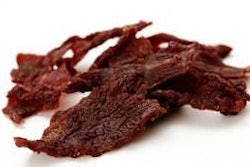The US Food and Drug Administration (FDA)'s release this week of an update on the investigation into illnesses related to jerky pet treats really blew up on the Internet and social media. While one of FDA's intentions in issuing the update was to ask veterinarians for information on such illnesses they have treated, what mainstream and social media seized on and emphasized were the numbers: more than 3,000 complaints, over 3,600 dogs affected (plus 10 cats) and more than 580 deaths.
Of course, those numbers are significant and cause for great concern. What seems to be missing in all the news reports and social media posts (at least judging by my Facebook feed) is any sort of context. FDA has been receiving and tracking complaints since late 2011; by May 2012, the agency had received nearly 900 reports of illnesses. Its new report stated that the "rate of complaints associated with jerky pet treats dropped sharply after several well-known brands were removed from the market in January 2013"; and, the agency added, it believes the decline in complaints is at least partially due to the decreased availability of jerky treats on the market.
(Those recalls at the beginning of this year were of Del Monte's brand of chicken jerky treats, Milo's Kitchen, and Nestle Purina's brands, Waggin' Train and Canyon Creek Ranch. At the time, a study conducted by the New York State Department of Agriculture and Marketing detected low levels of antibiotic residues in the products, but after further investigation, FDA has nearly ruled out antibiotics as the cause of the illnesses.)
While it probably doesn't help consumer confidence (or even our industry's confidence) that no one, including FDA, has been able to determine the cause of the illnesses, I do think it's worth emphasizing the sharp decrease in complaints, especially in relation to the near hysteria the FDA update seems to be causing this week. Another positive, in my mind, is that FDA is proactively reaching out to veterinarians for help and information and seeking to better utilize its Vet-LIRN tool.
He seemed quite enthusiastic about it, and his enthusiasm rubbed off on me: I remember thinking that the network could create great potential for collaboration between veterinarians, FDA and, even possibly, petfood manufacturers. I also saw opportunities for education of veterinarians on pet nutrition and petfood and, at the same time, heightened awareness for FDA and manufacturers of veterinarians' and consumers' concerns and needs. I may have been reading way too much into it; regardless, I don't think FDA has used the network to its full potential or, if it has, it has not communicated that. So perhaps something good in terms of improved collaboration and communication will come out of the jerky pet treat investigation.
The other important element of this latest FDA update, of course, is the China connection. The agency states that nearly all of the 3,000-plus illnesses tracked so far have been related to chicken, duck or sweet potato treats imported from China. Since the 2007 melamine-related recalls, which were directly tracked to an ingredient imported from China, pet owners have understandably been wary and suspicious of any ingredient or product exports from China. This latest report just deepens that suspicion and proves that, though China is a booming and fast growing pet care market, its fledgling petfood manufacturing industry has a long way to go.
Interestingly, while most pet owners in China buy multinational brands of petfood vs. domestic brands, 80% buy "natural" jerky treats made in China from the e-commerce portal on Goumin.com, the country's largest social network for pet owners. It makes you wonder if any Chinese pets have suffered similar illnesses to the 3,600-plus US pets sickened by jerky treats, and no one outside of China has heard about it.
Facebook

















